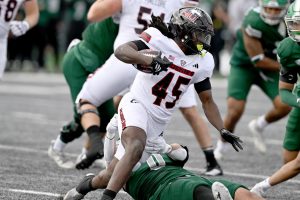Exhibition this!
January 20, 2005
Three art galleries that opened in January are associated with NIU.
Misleading Trails opened to the public on Tuesday in Altgeld Hall’s South Galleries. It features primarily Asian artists playing with the theme of underlying messages and social commentary. This exhibition opened in China, and DeKalb is the first of eight stops at colleges in America.
“It was Dan Mills who helped bring this exhibition and others to NIU,” said Jo Burke, the assistant director of Altgeld’s art museum.
Misleading Trails features works by NIU alumnus and co-curator Dan Mills and six other artists.
A new exhibition opened Jan. 8 at the NIU Art Museum in Chicago, 215 W. Superior. The In(visible) Body exhibition was christened with white wine at its reception with a 200-person turnout.
“The NIU Art Museum in Chicago only opens with wine, while the art museum in DeKalb opens only with food, that’s the budget,” interim director Heather Weber said.
The exhibition is an artistic study on the internal workings of the human body. Associate art professor Christine LoFaso, and alumna Karen Jayne both contributed to the exhibition. These artists are sometimes interested in the less sterile investigation of the inside of the human body, and also medical grafting, transplants and MRIs.
Another exhibition opened this January at the Nehring Center Gallery, at the corner of Lincoln Highway and Second Street.
The NIU/Lyric Opera of Chicago Historic Scenic Collection opened to a crowd of 50 patrons.
About 10 years ago, co-curator Alexander Adduci made an agreement with the now closed Lyric Opera of Chicago to store the largest collection of scenic art of the late 19th/early 20th century.
“The maquettes should be considered national treasures,” said Charles Elson, professor emeritus of Yale University. “They compare with the finest examples in Europe.”
The university stores more than 900 backdrops averaging 68 feet by 40 feet in size;120 detailed maquettes and archival documents of frantic budget ledgers; and set drafts associated with the operas of Oscar Hammerstein’s Manhattan Opera Company and the creation, rise and development of the opera in historic Chicago.
The collection has been accessible only by appointment, besides its tour to Europe and infrequent exhibitions at neighboring universities.






